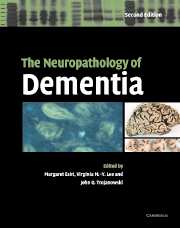Book contents
- Frontmatter
- Contents
- List of contributors
- List of abbreviations
- Preface to second edition
- 1 Definition, clinical features and neuroanatomical basis of dementia
- 2 Important anatomical landmarks in the brain in dementia
- 3 Practical approach to pathological diagnosis
- 4 Morphometric methods and dementia
- 5 Safety precautions in laboratories involved with dementia diagnosis and research
- 6 Molecular diagnosis of dementia
- 7 Neuropathology of the ageing brain
- 8 Neuroimaging Alzheimer's disease
- 9 Alzheimer's disease
- 10 Down's syndrome and Alzheimer's disease
- 11 Sporadic tauopathies: Pick's disease, corticobasal degeneration, progressive supranuclear palsy and argyrophilic grain disease
- 12 Hereditary tauopathies and idiopathic frontotemporal dementias
- 13 Vascular dementias
- 14 Familial and sporadic cerebral amyloid angiopathies associated with dementia and the BRI dementias
- 15 Parkinson's disease, dementia with Lewy bodies, multiple system atrophy and the spectrum of diseases with α-synuclein inclusions
- 16 Huntington's disease
- 17 Human prion diseases
- 18 Alcoholism and dementia
- 19 Hydrocephalus and dementia
- 20 Head injury and dementia
- 21 Infectious (and inflammatory) diseases causing dementia
- 22 Schizophrenia and its dementia
- 23 Other diseases that cause dementia
- 24 Transgenic mouse models of neurodegenerative disease
- Appendix: Dementia brain banks
- Index
2 - Important anatomical landmarks in the brain in dementia
Published online by Cambridge University Press: 12 October 2009
- Frontmatter
- Contents
- List of contributors
- List of abbreviations
- Preface to second edition
- 1 Definition, clinical features and neuroanatomical basis of dementia
- 2 Important anatomical landmarks in the brain in dementia
- 3 Practical approach to pathological diagnosis
- 4 Morphometric methods and dementia
- 5 Safety precautions in laboratories involved with dementia diagnosis and research
- 6 Molecular diagnosis of dementia
- 7 Neuropathology of the ageing brain
- 8 Neuroimaging Alzheimer's disease
- 9 Alzheimer's disease
- 10 Down's syndrome and Alzheimer's disease
- 11 Sporadic tauopathies: Pick's disease, corticobasal degeneration, progressive supranuclear palsy and argyrophilic grain disease
- 12 Hereditary tauopathies and idiopathic frontotemporal dementias
- 13 Vascular dementias
- 14 Familial and sporadic cerebral amyloid angiopathies associated with dementia and the BRI dementias
- 15 Parkinson's disease, dementia with Lewy bodies, multiple system atrophy and the spectrum of diseases with α-synuclein inclusions
- 16 Huntington's disease
- 17 Human prion diseases
- 18 Alcoholism and dementia
- 19 Hydrocephalus and dementia
- 20 Head injury and dementia
- 21 Infectious (and inflammatory) diseases causing dementia
- 22 Schizophrenia and its dementia
- 23 Other diseases that cause dementia
- 24 Transgenic mouse models of neurodegenerative disease
- Appendix: Dementia brain banks
- Index
Summary
In this chapter we summarize the more important structures in the brain with which it is essential to be familiar when studying the pathological basis of dementia. As described in Chapter 3 many dementing conditions are impossible to distinguish on naked eye examination of the brain since they do not display gross regional pathology. In order to reach the correct diagnosis, it is necessary to select the appropriate areas for more detailed examination. To do that requires knowledge of the parts of the brain that are significant in the particular context of dementia. For more detailed information textbooks of neuroanatomy such as Paxinos (1990), Heimer (1995), Parent (1996), or Nolte (2001) should be consulted.
Cerebral cortex
Chapter 1 has already emphasized the crucial importance of the cerebral cortex for the cognitive functions which deteriorate in dementia. The cerebral cortex can be divided anatomically into a phylogenetically older and simpler allocortex consisting of the hippocampus and closely related entorhinal cortex, subiculum and olfactory regions, and the remaining, much more voluminous and phylogenetically more recent, neocortex.
Hippocampus, subiculum and entorhinal cortex (archicortex allocortex)
These structures have already been mentioned in Chapter 1 but because of their importance it is worth providing a brief supplementary account here. Excellent reviews of the structure of the human hippocampus and related cortex can be found in Amaral and Insausti (1990) and Duvernoy (1988).
The entorhinal cortex lies in the uncus and anterior parahippocampal gyrus and forms an intermediate type of cortex between the complex six-layered neocortex of the temporal lobe and the simpler, basically three-layered, cortex of the hippocampus.
- Type
- Chapter
- Information
- The Neuropathology of Dementia , pp. 34 - 47Publisher: Cambridge University PressPrint publication year: 2004



